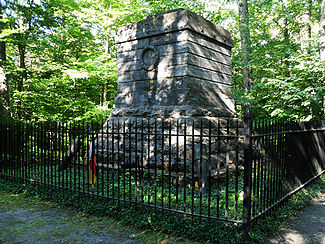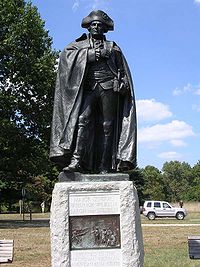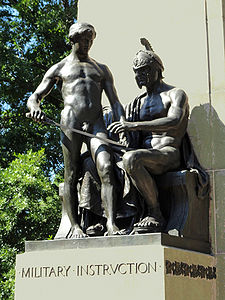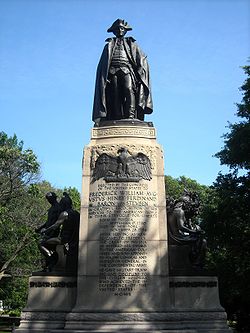Friedrich Wilhelm von Steuben: September 17, 1730-November 28, 1794
Adapted from Wikipedia, the free encyclopedia October 16, 2008, 5:05 pm
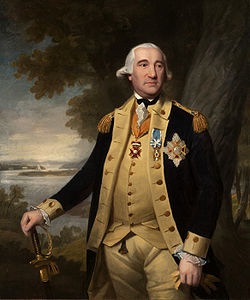
Friedrich Wilhelm von Steuben (born Friedrich Wilhelm Ludolf Gerhard Augustin von Steuben in Magdeburg, Germany, on September 17, 1730 – died in Utica, New York, on November 28, 1794) was a Prussian-German army officer who served as inspector general of the Continental Army during the American Revolutionary War.
He wrote the book that became the standard United States drill manual until the War of 1812, and essentially served as General George Washington's chief of staff in the final years of the war. Dubbed "the drillmaster of Valley Forge" by one recent biographer, he is credited with teaching the Continental Army the essentials of military training and discipline, helping to guide it to victory.[1]
Scandal
In 1776, Steuben's career at Hohenzollern-Hechigen ended in scandal when he was accused of having "taken familiarities with young boys" in his charge at Prince Joseph's court.[2] Whether or not this accusation was true is not known, but the rumors compelled him to seek employment elsewhere. Steuben tried employment in several foreign armies including the Habsburg Monarchy, in Austria, Baden, in Germany, and France.[3]
According to his recent biographer Paul Douglas Lockhart, Steuben "may have been [homosexual], and there is circumstantial evidence to suggest it: his friendship with Prince Henry, the accusations of pederasty at Hechingen, his undisguised affection for [Benjamin] Walker, [William] North, and [John-Baptiste Lazare Theveneau de] Francy. But there is also circumstantial evidence to the contrary. . . ." and "this murkiest aspect" of Steuben's personality remains shrouded in mystery" (203); Steuben "spent nearly all of his time in the exclusively male society of the army. Whether Steuben was homosexual or heterosexual, or asexual . . . may never be known with any certainty" (204).[4]
Steuben never married and had no children. He left his estate to General Benjamin Walker and Captain William North, who had served as his aides-de-camp during the war, and with whom he had had a "extraordinarily intense emotional relationship".[5] He is buried at what is now the Steuben Memorial State Historic Site.
To America
Looking for work, Steuben traveled to Paris in the summer of 1777. Earlier, he had been introduced to the French Minister of War, Claude Louis, Comte de Saint-Germain. The Count, fully realizing the potential of an officer with Prussian general staff training, introduced him to Benjamin Franklin. Upon the Count's recommendation, Steuben was introduced to George Washington by means of a letter from Franklin. The letter called Steuben a "Lieutenant General in the King of Prussia's service," an exaggeration of his actual credentials that appears to be based on a mistranslation of his service record. He was advanced travel funds and left for America from Marseilles.
Early life
Steuben was born at Magdeburg, Duchy of Magdeburg, the son of Wilhelm Augustin Steuben (1699-1783), a lieutenant of engineers. His mother was Elizabeth von Jagvodin. Steuben accompanied his father to the Russian Empire when King Frederick William I of Prussia and Elector of Brandenburg, ordered Wilhelm into the service of Czarina Anna I, of Russia. The family returned to Prussia after the accession of Frederick II of Prussia (Frederick the Great) to the throne in 1740.
Steuben was schooled in Wrocław|Breslau by Jesuits and, by the age of 17, was a Prussian officer in the military. During the Seven Years' War he was a member of an infantry unit but served primarily as a staff officer. By 1761 he had risen to the rank of captain and was serving in the Prussian general headquarters. The army was greatly reduced in size at the end of the war, and Steuben was one of many Prussian officers suddenly without work. His Prussian military career would later be exaggerated—he was not one of Frederick the Great's generals—but his experience on a professional general staff, an agency then practically unknown outside of Prussia, would prove to be valuable in his American career.
Between the wars
In 1764 Steuben became chamberlain at the petty court of Hohenzollern-Hechingen. In 1769, he started using the title of baron, based on a falsified lineage prepared by his father.[3] He was the only courtier to accompany his incognito prince to France in 1771, hoping to borrow money. Failing to find funds, they returned to Germany in 1775, deeply in debt.
American Revolution
On September 26, 1777, he reached Portsmouth, New Hampshire and by December 1, was extravagantly entertained in Boston. Congress was in York, Pennsylvania, after being ousted from Philadelphia by the British advance. By February 5, 1778, Steuben had offered to volunteer without pay (for the time), and by the 23rd, Steuben reported for duty to Washington at Valley Forge. Steuben spoke little English, but German and French were known by many officers. Many troops were immigrants and therefore spoke German. Colonels Alexander Hamilton and Nathanael Greene were of great help in assisting Steuben in drafting a training program for the Army, which found approval with Washington.
Training program
Steuben's training technique was to create a "model company", a group of 120 chosen men who in turn successively trained other personnel at Regimental and Brigade levels. Steuben's eclectic personality greatly enhanced his mystique. He trained the soldiers, who at this point were greatly lacking in proper clothing themselves, in full military dress uniform, swearing and yelling at them up and down in German and French. When that was no longer successful, he recruited Captain Benjamin Walker, his French speaking aide, to curse at them for him in English. Steuben introduced a system of progressive training, beginning with the school of the soldier, with and without arms, and going through the school of the regiment. This corrected the previous policy of simply assigning personnel to regiments. Each company commander was made responsible for the training of new men, but actually instruction was done by selected sergeants, the best obtainable.
Another program developed by Steuben was camp sanitation. He established standards of sanitation and camp layouts that would still be standard a century and a half later. There had previously been no set arrangement of tents and huts. Men relieved themselves where they wished and when an animal died, it was stripped of its meat and the rest was left to rot where it lay. Steuben laid out a plan to have rows for command, officers and enlisted men. Kitchens and latrines were on opposite sides of the camp, with latrines on the downhill side. There was the familiar arrangement of company and regimental streets.
Perhaps Steuben's biggest contribution to the American Revolution was training in the use of the bayonet. Since the Battle of Bunker Hill, Americans had been mainly dependent upon using their ammunition to win battles. Throughout the early course of the war, Americans used the bayonet mostly as a cooking skewer or tool rather than as a fighting instrument. Steuben's introduction of effective bayonet charges became crucial. In the Battle of Stony Point, American soldiers attacked with unloaded rifles and won the battle solely on Steuben's bayonet training.
The first results of Steuben's training were in evidence at the Battle of Barren Hill, 20 May, 1778, and then again at the Battle of Monmouth in June 1778. Steuben, by then serving in Washington's Headquarters, was the first to determine the enemy was heading for Monmouth. Washington recommended appointment of Steuben as Inspector General on April 30; Congress approved it on May 5. During the winter of 1778-1779, Steuben prepared Regulations for the Order and Discipline of the Troops of the United States, commonly known as the "Blue Book."[6] Its basis was the training plan he had devised at Valley Forge.
Southern campaign
The following winter (1779-1780) Steuben's commission represented Washington to Congress regarding the reorganization of the army. In 1780 Steuben sat on the court-martial of the British Army officer Major John André, captured and charged with espionage in conjunction with the defection of General Benedict Arnold. He later traveled with Nathanael Greene, the new commander of the Southern campaign. He quartered in Virginia since the American supplies and soldiers would be provided to the army from there. During the spring of 1781, he aided Greene in the campaign in the south, culminating in the delivery of 450 Virginia Continentals to Lafayette in June.
He was forced to take sick leave, rejoining the army for the final campaign at Yorktown, where his role was as commander of one of the three divisions of Washington's troops. Steuben gave assistance to Washington in demobilizing the army in 1783 as well as aiding in the defense plan of the new nation. He was discharged from the military with honor on March 24, 1783.
Final years
Steuben became an American citizen by act of the Pennsylvania legislature in March 1784 (and later by the New York authorities in July 1786). With the war over, Steuben resigned from service in 1784 and first settled on Manhattan Island, where he became a prominent figure and elder in the German Reformed Church. His business acumen was not very keen and in the depression following the War, found himself in difficult financial conditions, particularly because Congress did not pay a promised pension nor compensate him for wartime expenses. After his friend Alexander Hamilton became Secretary of the Treasury, Hamilton, with support of President Washington, submitted Steuben's expenses to Congress, which in 1790 finally voted him a yearly pension of $2,500.
Steuben eventually settled on a small estate in the vicinity of Utica, New York, on land granted to him for his military service. He later assisted in the founding of the Society of the Cincinnati and was appointed a Regent for what evolved into the State University of New York.
Legacy
- Von Steuben has a holiday which takes place in September in the United States. It is a often considered the German-American event of the year. Participants march, dance, wear Germanic costumes and play Germanic music, and the event is attended by millions of people. The largest event is the Annual German-American Steuben Parade in New York City, which is traditionally followed by a Volksfest (People's Festival) in Central Park as well as celebrations in Yorkville, Manhattan, a traditionally German section of New York City. The German-American Steuben Parade has been taking place since 1957. Chicago's von Steuben Day parade is featured in the American movie "Ferris Bueller's Day Off." Philadelphia is also known to host a very large von Steuben Parade that runs throughout the Northeast of the city.
- The post-World War I years were difficult times for the German-American community during which they reorganized their main association into the Steuben Society, now the largest organization for Americans of German extraction.
- A warship, a submarine, and an ocean liner (later pressed into military service) were named in von Steuben's honor. In World War I the captured German ship Template:SS was renamed as USS Von Steuben, and in World War II there was the Dampfschiff General von Steuben, an ill-fated German luxury passenger ship which was turned into an armed transport ship during the war. During the Cold War, the US Navy submarine Template:USS was named for him.
- Several locations in the United States are named Steuben, most of them in his honor. Examples include Steuben County, New York, Steuben County, Indiana, and the city of Steubenville, Ohio.
- Von Steuben Metropolitan Science Center is a public high school in Chicago, Illinois.
- Steuben is one of four European military leaders who assisted the American cause during the Revolution honored with a statue in Lafayette Square just north of The White House in Washington, DC.
- The Steuben House presented to Steuben as a gift for his services in the Continental Army is located in River Edge, New Jersey. Originally belonging to a Loyalist family, the house and surrounding farmland were seized in 1781. It was bought by the county of Bergen in 1928 for $9,000 and preserved as a national monument and public museum. The area around the house is used for both Revolutionary and Civil War re-enactments.
- The Hamilton College football team plays on Steuben Field constructed in 1897, one of the top ten oldest collegiate football fields in the United States.[7] The field is named for Baron von Steuben who laid the cornerstone of the school acting as Alexander Hamilton's surrogate. Upon graduating, all Hamilton seniors receive a cane as a gift from the college. The cane's design features a tricorn hat at the top of the cane to honor von Steuben.
- The various depictions of Steuben in popular (American) media include portrayals by Nehemiah Persoff in the 1979 U.S. TV Miniseries The Rebels, Kurt Knudson in the 1984 TV miniseries George Washington, and being voiced by Austrian-American Arnold Schwarzenegger in the animated series Liberty's Kids.
- Steuben has been cited (most notably by Randy Shilts in his book Conduct Unbecoming) as an early example of a gay man in the military, but the evidence in this matter is inconclusive.[8]
- For ships named after General von Steuben|Von Steuben see Wikipedia.
References
- ↑ CITATION NEEDED
- ↑ Paul Douglas Lockhart, The Drillmaster of Valley Forge: The Baron de Steuben and the Making of the American Army (New York: HarperCollins, September 9, 2008), p. 42. On what Lockhart calls Steuben's homosexuality also see pages 203-04.
- ↑ 3.0 3.1 Philander D. Chase. "Steuben, Friedrich Wilhelm von". American National Biography Online, February 2000.
- ↑ The Drillmaster of Valley Forge: The Baron de Steuben and the Making of the American Army (New York: HarperCollins, September 9, 2008), p. 42. On what Lockhart calls Steuben's homosexuality also see pages 203-04.
- ↑ William B. Skelton. "North, William"; American National Biography Online, February 2000.
- ↑ This book is available for download at sgtstime.com
- ↑ NESCAC Football Record Book
- ↑ Template:Cite web
External links
Collaborators on this entry
Katz, Jonathan Ned
Steakley, James
- Continental Army generals
- Continental Army staff officers
- German immigrants to the United States
- German people of the American Revolution
- German-American military personnel
- Immigration
- Military
- Naturalized citizens of the United States
- People from Magdeburg
- People from the Duchy of Magdeburg
- Prussian Army personnel
- 1730 births
- 1794 deaths
